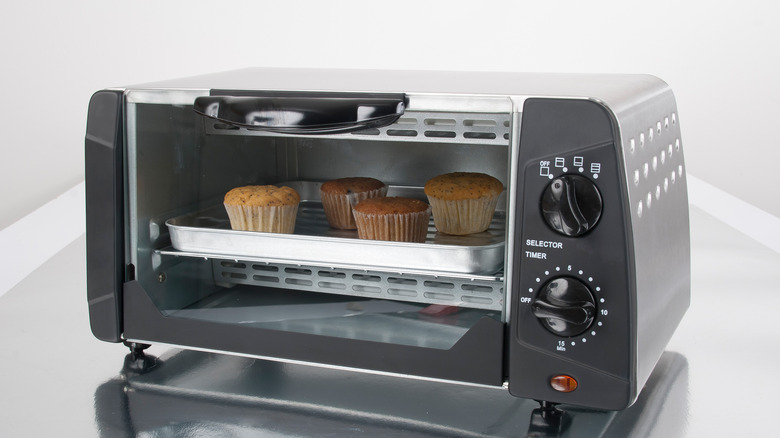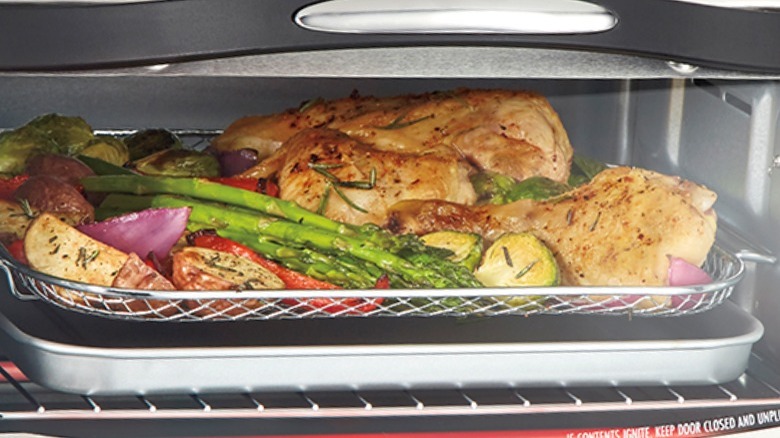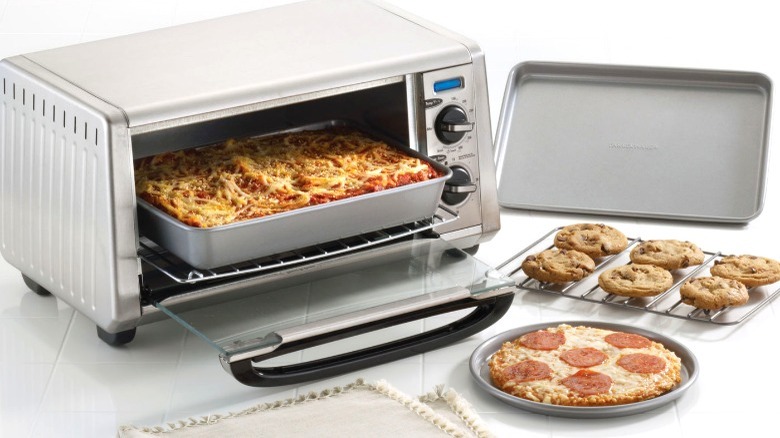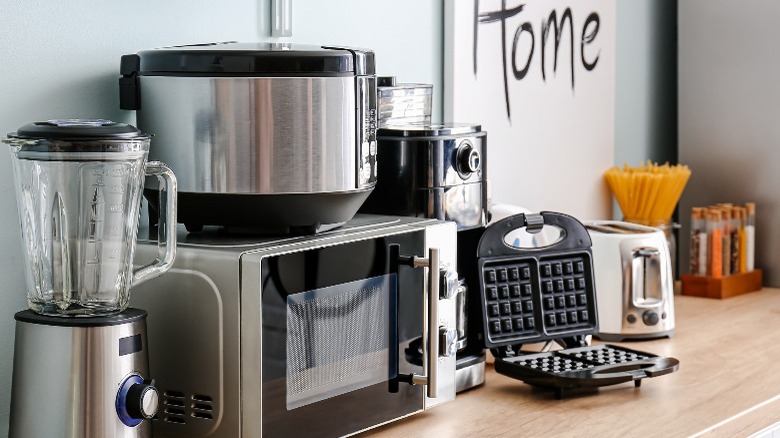12 Mistakes Everyone Makes With Toaster Ovens
We may receive a commission on purchases made from links.
The smell of burnt toast is never a good omen (nor is eating burnt toast a good thing). It can indicate a medical condition, or it could simply mean you burnt your toast. Either way, not good. If you can't seem to fend off that unmistakable scent whenever you're making breakfast, it's possible you're committing a toaster oven offense.
Countertop toaster ovens are far from a new commodity, but their popularity has only risen in recent years. A report from Statista indicates that toaster oven sales have increased steadily since 2010, with 9.6 million units sold nationwide in 2019. But just because they're ubiquitous doesn't mean they're foolproof. At best, toaster ovens are underused; at worst, they could become a serious health hazard. Here are some mistakes too many people make with the toaster oven, how to prevent them, and tips to ensure you're getting the most out of one of the most versatile kitchen appliances out there.
1. You're not getting a combo model
For most of us, counter space and storage space are both hot commodities in the kitchen. You want to make sure there's enough room to do your prep work, and life's too short to wade through container lids and loose cables every time we want to heat up a Toaster Strudel.
Luckily, there are several toaster oven combos out there that will help reduce kitchen clutter and feed two birds with one (lightly toasted) scone. You already made the right choice by getting a toaster oven over a conventional toaster, so you might as well lean into its versatility.
Get yourself a toaster oven that will also act as an air fryer (which is essentially a countertop convection oven), because everyone deserves still-crisp leftovers and the best possible freezer fries. And if it comes down to it and you have to choose between a microwave and a toaster oven, don't settle and instead spring for a microwave-toaster combo. This will give you the convenience and speed of a microwave plus the flexibility of a toaster oven.
2. You're overcrowding your toaster oven
Overcrowding is almost always a cooking no-no. If your sheet tray's overcrowded with veggies, they'll never brown to roasted perfection; if your skillet's overcrowded with meat, it will never sear properly. The toaster oven is no exception. It may be tempting to shove in as many slices as possible for the sake of efficiency, but just don't. Besides, why do you need all that toast? Are the Gergiches coming over?
When a pan has too much food in it, per Real Simple, the heat will get trapped under the food, cooking it with steam (a moist-heat method, which will lead to soggy eats) rather than a sear (a dry-heat method, which will yield a nice caramelized crust).
Steam is less of an issue when making toast, but if slices are overlapping, those edges will not crisp up at the same rate as the rest of the bread. Crowded toast means unevenly cooked toast; to be safe, space your slices out and stick to the capacity that your model says it can handle.
3. You're letting the toaster oven get dirty
Bread tends to create a lot of crumbs as it toasts. Those crumbs have nowhere to go but down, and as they sit there, they'll continue to toast, leaving an unpleasant burning smell. Worse, if food particles continue to crowd around the heating element, according to emergency services company Jenkins Restorations, the buildup can catch fire. That's why it's important to always use a crumb tray and to clean it regularly — and the same goes for normal toasters, as well. Fortunately, most models come with one that can easily slide in and out.
The Yale University Office of the Fire Marshall recommends emptying and cleaning the crumb tray daily. As for the best way to go about doing so, Consumer Reports' Cindy Fisher, who specializes in countertop appliances, says it's best to wash them with soap and water, let them soak in the sink overnight, then let them dry completely.
4. You're not using the toaster oven for small batch cooking
Are you turning the oven on every time you make a meal for yourself? Stop that, and turn instead to your trusty toaster oven. The countertop appliance is a godsend for individuals or couples who often find themselves cooking in small batches. In fact, it might be possible to avoid turning the actual oven on entirely and allow the toaster oven to fully live up to the latter half of its name.
A toaster can conserve over 50% of the energy required of a conventional electric oven when cooking a small- or medium-sized meal, according to the American Council for an Energy-Efficient Economy's "Consumer Guide to Home Energy Savings" (via Energy Star). And due to its compact size, a toaster oven will actually take less time to heat up than a normal oven. Energy savings mean financial savings, too. Perfect for Home points out that consumers might spend about three cents to run a toaster oven for one hour, versus seven cents with a gas oven and 16 cents with an electric oven.
5. You're not using bakeware
Many toaster ovens will come with a flimsy sheet tray, but that should only be the beginning of your accessories journey. There are all kinds of bakeware that are specifically designed to fit into a small, countertop appliance. These items will open the gates to all sorts of possibilities of what can be made with the toaster oven. (Muffin frittatas, cornbread, and bacon? Yes please.) Plus, unless specified otherwise, they're totally fine to use in a regular oven as well.
Epicurious' Emily Johnson says that Chicago Metallic's four-piece carbon steel set, which includes a 9.5 by 6.25-inch baking pan, a similarly-sized cooling rack, an 11 by 7-inch roasting or cake pan, and a six-cup muffin pan, is a solid option. Johnson says the products made cooking in a toaster oven "feel like actual cooking, and not playing with an Easy-Bake Oven." Additional sets also include round cake pans and a loaf pan.
6. You're leaving the toaster oven plugged in
While toaster ovens are less likely to go up in flames when not in use, there is still the possibility of a malfunction causing a fire, particularly if the appliance is still plugged into an electrical outlet. Between 2007 and 2011, toasters and toaster ovens led to almost 3,000 house fires, totaling over $27 million in damage, according to The Infinite Kitchen. Too many appliances plugged into the same circuit can also cause an overload, leading to an electrical short or, again, fire.
One way to reduce this risk is by leaving the toaster oven unplugged when not in use. In fact, the U.S. Consumer Product Safety Commission advises this as a rule of thumb for all countertop kitchen appliances. The agency adds that cords should be arranged so that they don't touch any potentially hot surfaces (such as the stovetop) and are kept away from the sink.
7. You're not using the warm setting
The toaster oven can be your best friend during holiday meals. We're not saying you should make an entire Thanksgiving spread in there (though it can be done, according to The Huffington Post), but it can at least play a supporting role as dishes are going in and out of the oven. Many toaster ovens feature a "warm" or "keep warm" setting, which keeps the interior between 130 and 180 degrees, and depending on the model, will only use the top heating elements at 50% (via The Brilliant Kitchen). Some even have "proof" settings so you can live your "Great British Baking Show" fantasy.
The warm setting won't continue to cook food, but it will make sure it's still hot by the time everyone is ready to eat. Let's say you already roasted some sprouts, but the turkey still needs some time in the oven — and you haven't even started on the rolls. Take advantage of your toaster oven by throwing whatever's done onto an oven-safe tray and letting them sit in there at a low temperature. Then by the time your turkey's rested, you've got hot-out-of-the-oven rolls — and still-warm veggies.
8. You're not using the broil setting
Compared to "warm," "broil" is on the opposite end of the spectrum, but it's just as useful. Broiling is the gateway to chef-worthy finishing touches — crispy chicken skin, melted cheese that's golden and gooey, a sugary caramel crust, and so much more — and it can all be done in a toaster oven.
Like the "warm" setting, "broil" uses only the top heating elements. Rather than a gentle heat, however, it's set to an intense, high temperature. Think of it as a built-in blow torch on the roof of the appliance. The couple behind the blog Toaster Oven Love advises using the highest rack placement when broiling, though you should adjust it to a lower position if the food is touching any of the top heating elements or if you find it's burning too quickly.
In addition to helping master those final details, the broiling can also help in cooking proteins like steak in the toaster oven; LiveStrong says it's an especially effective method with sirloin, T-bone, and ribeye. It has its benefits, too: According to Your Kitchen Trends, broiling requires less time and less oil than other cooking methods, and can produce more flavor.
9. You're not preheating the toaster oven
As discussed, toaster ovens can do just about anything a normal oven could (albeit on a smaller scale). That also means that many of the rules you'd follow when using an oven apply with a toaster oven. Preheating is one of those rules, especially if cooking or baking something from its raw state (via My Budget Recipes).
According to Food52, introducing cold or raw elements to an adequately heated oven is crucial to a flakey crust, risen biscuits, finely crumbed cakes, and more; those leavening agents need a burst of heat at the start for a proper rise.
The good news is that a toaster oven will preheat considerably faster than a regular oven, due to its size. Also, this step is less important when making toast (preheating is part of the toast-making cycle) or reheating leftovers (so long as your food's getting warm, you're fine). Otherwise, make sure the toaster oven has reached the proper temperature before continuing.
10. You're not checking the toaster oven's temperature
Using kitchen appliances is kind of like online dating: not everyone out there is trying to deceive you, but someone's inevitably going to lie to your face. Take the oven, for example. No matter what number the dial says, the actual temperature might be wildly off. America's Test Kitchen, when taking the temperature of five home ovens set to 350 degrees, found that some were off by 50 degrees; Bon Appétit editor Sarah Jampel says her home oven is off by 75 degrees.
The same can happen with toaster ovens. Toaster Oven Love conducted a handful of temperature tests on their device and found several discrepancies — not 75-degree level, but enough to cause the bloggers to make adjustments to cooking times.
An oven thermometer will show just how accurate (or inaccurate) that temperature dial is. Fancier models can simultaneously gauge the environmental temperature of the oven and the internal temperature of what's being cooked, and can alert you if the temperature's getting too off the mark. But something simpler will also do the trick; consider a compact version that will fit in both the standard oven and toaster oven.
11. You're sticking metal or your fingers in there
We've all made the mistake of eagerly reaching for our perfectly browned toast, only to burn our fingers. And if our hand accidentally brushes the oven rack or baking sheet? Yikes. While it might be easy to just reach for the nearest butter knife or fork, that could be a dangerous or even fatal move.
As toaster ovens emit an electric current while in use, a metal object inserted into it will act as a conductor, and if your hand's on the other end of that metal object, it can seriously shock you. According to the U.S. Consumer Product Safety Commission, small appliances (including toaster ovens) were the second most common product associated with electrocutions between 2004 and 2013, resulting in 61 deaths nationally.
If you need some extra help getting that slice of toast out of there, your best bet would be some wooden tongs; no shock risk, and they won't burn as easily as plastic (or skin). Some are actually pretty cute, and could be used as serving utensils as well. Disposable wooden chopsticks would also work in a pinch. Still, be careful not to prod to the point of damaging the appliance.
12. You're stacking items on top of it
Despite their myriad benefits, toaster ovens aren't always the best at keeping the heat insulated. This means that, unlike a microwave, the outside can get very hot — sometimes too hot to touch. As tempting as it might be to use the top as extra storage, doing so runs the risk of items overheating, melting, or burning, and The Brilliant Kitchen strongly advises against it. In fact, toaster oven manuals for Hamilton Beach, Cuisinart, Black & Decker, and more stipulate in the safeguards that no items should be stored on top of the appliance when in use or before it fully cools down (via ManualsLib.com).
Fortunately, there are some workarounds if you really can't give up that counter space. Get yourself a bamboo cutting board that's designed to fit on top of your toaster oven. Some even feature silicone feet to prevent the heat from transferring. Another option, if you have ample space above the toaster, is a standing shelf that will allow for some breathing room between the top of the toaster and the shelf.












